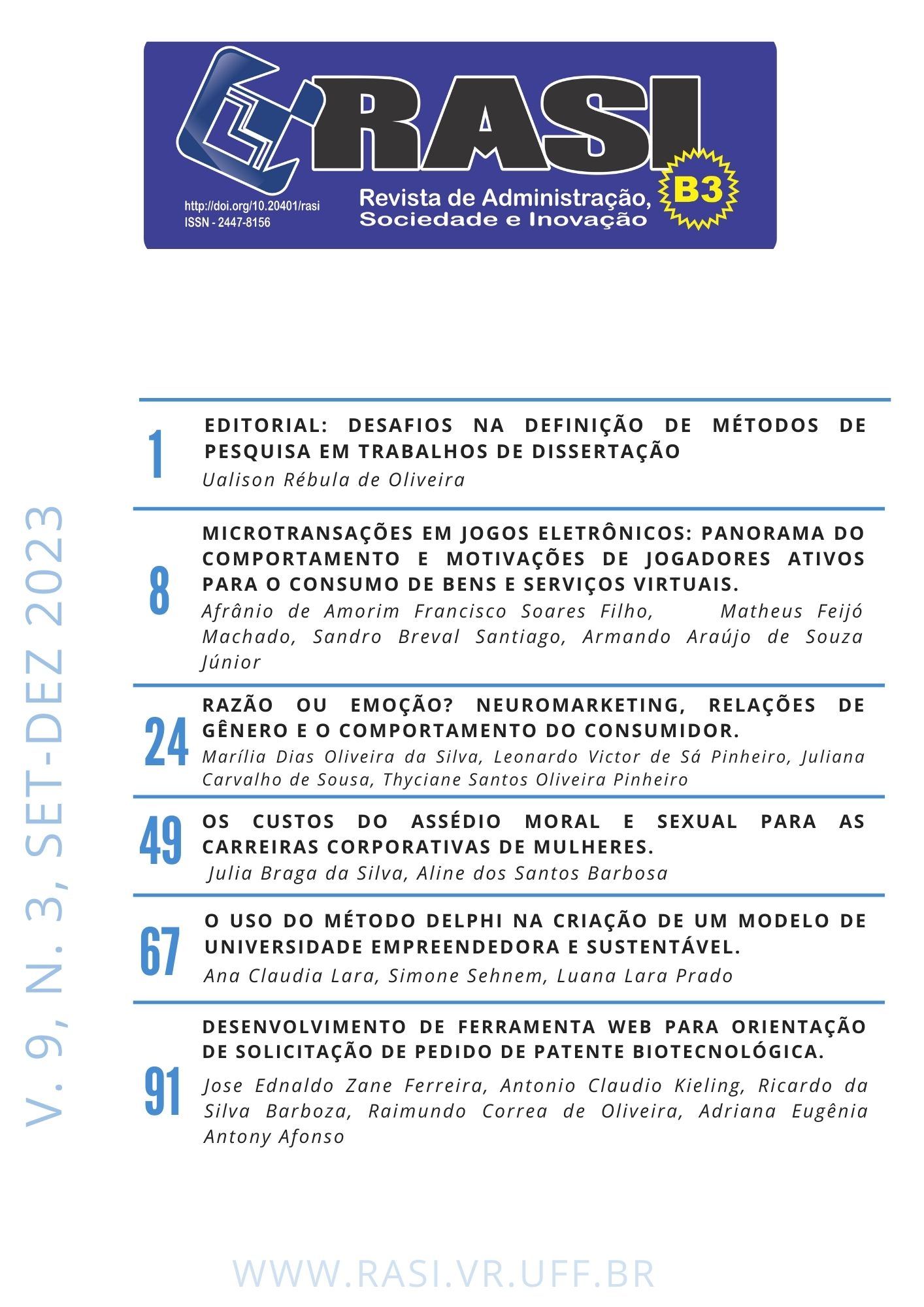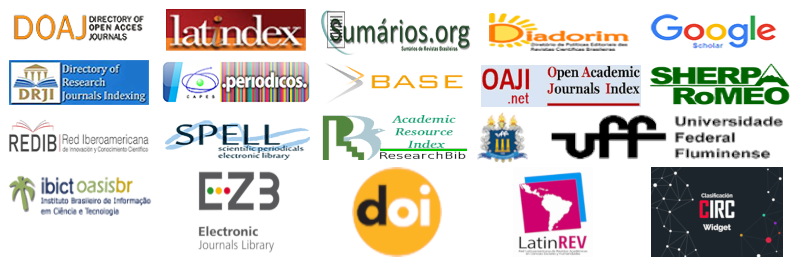Reason or Emotion?
Neuromarketing, Gender Relations and Consumer Behavior
DOI:
https://doi.org/10.20401/rasi.9.3.746Keywords:
Neuromarketing, Advertising, Consumer behavior, Feminine gender, Male genderAbstract
Understanding what goes through the minds of consumers is a strategic point for companies. Neuromarketing is a study that has provided a better understanding of human behavior, making it possible to identify factors that impact individuals when they have relied on brands, products or viewing advertisements. Therefore, the general objective of this research was to investigate the behavioral similarities and differences between men and women in the face of stimuli arising from neuromarketing applications. For this, a quanti-quali descriptive research was carried out, 42 individuals participated (21 men and 21 women) located in the Northeast and Southeast regions of the country The main results found show that both guidelines, reason and emotion, are the main factors that guide the purchase process of the female and male gender when purchasing a product. In addition, it was also possible to observe that women were more influenced by watching commercials and advertisements than men. The relevance of this research is given as it is possible to understand how consumers, whether female or male, behave in the face of marketing strategies, the media and advertising actions.
Downloads
References
Alsharif, A. H., Md Salleh, N. Z., Baharun, R., & Rami Hashem E, A. (2021). Neuromarketing research in the last five years: a bibliometric analysis. Cogent Business & Management, 8(1), 1978620.
Bardin, L. (2016). Análise de conteúdo. (70. ed.). São Paulo: Almedina Brasil.
Batista, L. L., Rodrigues, C. D. R., Brizante, J. G., & Franchesci, R. (2008). Aspectos cognitivos da percepção na propaganda. Ciências & Cognição, 13(3), 137-150.
Bianchin, G. L., & Druzian, R. (2020). As estratégias de neuromarketing e as possíveis influências no comportamento das gerações Y e Z: Um estudo de caso da Coca-Cola. Revista de Administração Dom Alberto, 7(10), 124-159.
Brastemp. (01 de maio de 2021). Brastemp Compartilhada Youtube [Vídeo]. Youtube. https://youtu.be/9pFc_3-niZg.
Bridger, D. (2018). Neuromarketing: como a neurociência aliada ao design pode aumentar o engajamento e a influência sobre os consumidores. (1. ed.). São Paulo: Autêntica Business.
Camargo, P. (2009). Neuromarketing: Descodificando a mente do consumidor. Portugal: Edições IPAM.
Colaferro, C. A., & Crescitelli, E. (2014). A Contribuição do Neuromarketing para o Estudo do Comportamento do Consumidor. Brazilian Business Review, 11, 130-153.
Edeka. (28 de novembro de 2015). EDEKA Weihnachtsclip - #heimkommen [Vídeo]. Youtube. https://youtu.be/V6-0kYhqoRo.
Falsarella, C. R. B. M., Oliveira, J. H. C. D., & Giraldi, J. D. M. E. (2017). The Influence of Celebrity Endorsement on Visual Attention: An Eye-Tracking Study in Brazil. Academy of Marketing Studies Journal, 21, 47-60.
Gil, A. C. (2008). Métodos e técnicas de pesquisa social. (6. ed.). São Paulo: Atlas.
Goulart, L. D., Gonçalves, V. V., Longo, L. B. F., Ventura, R. D. C. M. D. O., & Souza, R. A. D. (2019). A influência das redes sociais no processo de decisão de compra [Anais do Seminário]. In: Seminário Científico do UNIFACIG, (5). Minas Gerais: UNIFACIG.
Granato, L. A. C., & Pereira, P. F. P. (2011). Ainda existem consumidores fiéis?. Revista de Administração da Universidade Federal de Santa Maria, 4(1), 9-18.
Kotler, P., Kartajaya, H., & Setiawan, I (2017). Marketing 4.0. Rio de Janeiro: Sextante.
Kotler, P., Wong, V., Saunders, J., & Armstron, G. (2007). Principles of Marketing. England: Pearson Education Limited.
Lee, N., Broderick, A. J., & Chamberlain, L. (2007). What is ‘neuromarketing’? A discussion and agenda for future research. International journal of psychophysiology, 63(2), 199-204. https://doi.org/10.1016/j.ijpsycho.2006.03.007.
Lepre, T. R. F., Santos, G. T. D., Ricci, K. C. P., & Lepre, L. R. (2017). Neuromarketing – técnicas utilizadas por supermercados brasileiros. South American Development Society Journal, 2(5), 115-128.
Lima, L. D. S., Machado, J. A., Melo, P. G. S. D., & Neves, A. P. (2016). O uso do neuromarketing na formulação das estratégias de comunicação: O caso de uma indústria de pequeno porte em Boa Vista-RR [Anais do Simpósio]. In: V Simpósio Internacional de Gestão de Projetos, Inovação e Sustentabilidade. São Paulo: V SINGEP.
Mashrur, F. R., Rahman, K. M., Miya, M. T. I., Vaidyanathan, R., Anwar, S. F., Sarker, F., & Mamun, K. A. (2022). An Intelligent Neuromarketing System for Predicting Consumers’ Future Choice from Electroencephalography Signals. Physiology & Behavior, 113847.
Morin, C. (2011). Neuromarketing: a nova ciência do comportamento do consumidor. Sociedade, 48 (2), 131-135. https://doi.org/10.1007/s12115-010-9408-1.
Mozzato, A. R., & Grzybovski, D. (2011). Análise de conteúdo como técnica de análise de dados qualitativos no campo da administração: potencial e desafios. Revista de Administração Contemporânea, 15, 731-747. https://doi.org/10.1590/S1415-65552011000400010.
Neto, J. B. S., Dias, T. F., & Alexandre, M. L. (2010). Mapeando fundamentos do constructo neuromarketing com profissionais de empresas de publicidade. Revista Pretexto, 11(40), 27-55.
ODA, L. (2013). A Influência do Neuromarketing no Entendimento do Comportamento do Consumidor e na Área da Comunicação. Dissertação de Especialização, Programa de Pós-graduação em pesquisa de mercado aplicada em comunicações, Universidade de São Paulo, São Paulo.
Oliveira, A., & Oliveira, T. (2011). Elementos de estatística descritiva. Lisboa: Universidade Aberta.
Pereira, E. (2018). Perspectiva da Neurociência em Comunicação. Revista Estudos em Comunicação, 1(27), 39-51. https://doi.org/10.20287/ec.n27.v1.a03.
Pires, S. P. (2016). Neuromarketing e as influências no comportamento do consumidor. Monografia (Bacharelado em Tecnologia em Processos Gerenciais - Instituto Federal de São Paulo, São Carlos.
Poio, G. M., Trigueiro, F. M. C., & Leite, D. B. (2018). Fatores que influenciam a escolha de marcas e o comportamento de compra de consumidores do segmento de moda em Cuiabá-MT: similaridades e diferenças entre gêneros. Revista Estudos e Pesquisas em Administração, 2(1), 84-103. https://doi.org/10.30781/repad.v2i1.6204.
Ribeiro, B. L. (2014). Uma análise do Neuromarketing pela perspectiva de especialistas [Anais do Simpósio]. In: XI Simpósio de Excelência em Gestão e Tecnologia. Rio de Janeiro: XI SEGET.
Santos, A. I. D., & Cândido, D. (2017). Por um conceito de Propaganda e Publicidade: divergências e convergências. SEMPESq-Semana de Pesquisa da Unit-Alagoas, (5).
Shigaki, H. B., Gonçalves, C. A., & Santos, C. P. V. D. (2017). Neurociência do Consumidor e Neuromarketing: Potencial de adoção teórica com a aplicação dos métodos e técnicas em neurociência. Revista Brasileira de Marketing, 16(4), 439-453. https://doi.org/10.5585/remark.v16i4.3427.
Vieira, E. V., Reis, Z. C. D., Matte, J., Miri, D. H., Chais, C., Ganzer, P. P., & Olea, P. M. (2020). Aplicabilidade das técnicas de neuromarketing em empresas de grande porte da Serra Gaúcha. Revista Eletrônica de Estratégia & Negócios, 13(1), 3-26. https://doi.org/10.19177/reen.v13e120203-26.
Ullah, A., Baloch, G., Ahmed, A., Buriro, A. B., Junaid, A., Ahmed, B., & Akhtar, S. (2022). Neuromarketing Solutions Based on EEG Signal Analysis Using Machine Learning. International Journal of Advanced Computer Science and Applications, 13(1).
Underhill, P. (1999). Vamos às compras: a ciência do consumo. Rio de Janeiro: Elsevier Editora Ltda.
Downloads
Published
Issue
Section
License
Copyright (c) 2023 Review of Administration, Society and Innovation

This work is licensed under a Creative Commons Attribution 4.0 International License.
RASI, in accordance with Law No. 9,610 of February 19, 1998, which amends, updates and consolidates Brazilian copyright law and makes other provisions, adopts the following conditions of the Copyright Assignment:
1. RASI maintains, with the transfer of copyrights, the possession of rights over the content published;
2. The author retains his moral rights of the content, including the right to be identified as the author whenever the content is published;
3. Despite the attribution of copyright, the author retains the right to reuse the material in future collections of his own work without encumbrance. The acknowledgments of the previous publication in the RASI are the only requirements in such cases;
4. The author may make photocopies of the content, or distribute it by electronic mail or fax, provided that they are intended for their own classes and for the purpose of meeting research objectives, provided that: (a) such copies are not resold and (b) reference to the original source of the publication and the name of the RASI are clearly indicated on all copies made of the document.











